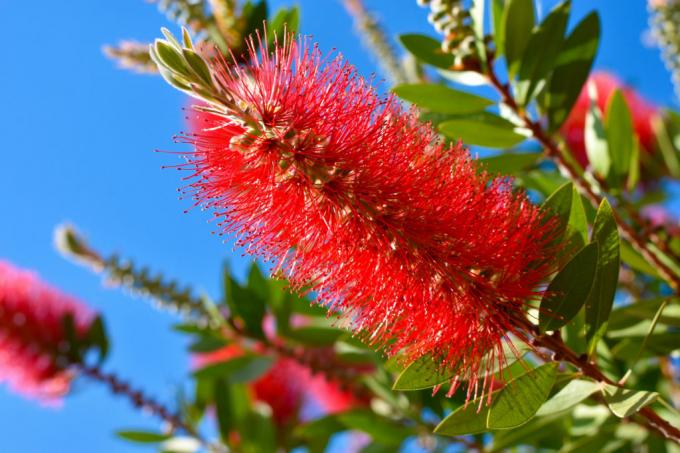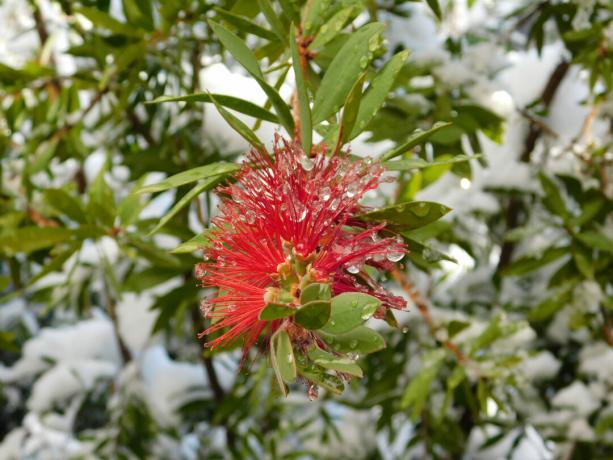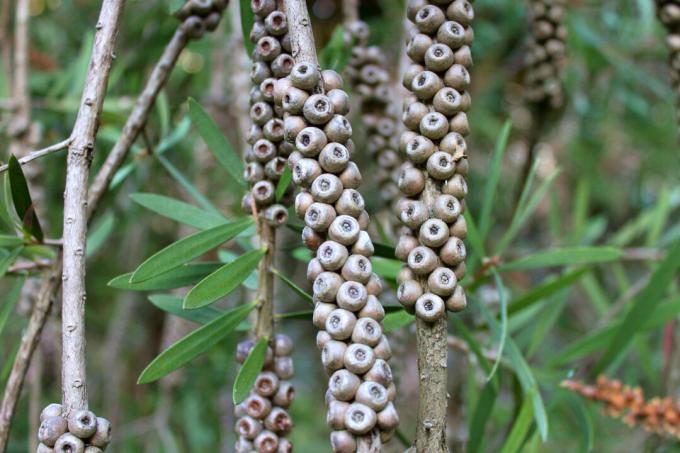How are cylinder brushes planted correctly and what needs to be considered when caring for them? All information about the so-called lamp cleaner shrub can be found here.

Bottlebrush (Callistemon) are very popular evergreen tub plants. With their exotic inflorescences, they transform your terrace or balcony into a beautiful tropical oasis in summer.
contents
- Bottlebrush: Origin & Characteristics
- Plant cylinder brush
-
Caring for cylinder brushes: This is to be considered when caring for them
- Watering cylinder brushes: Our tips
- This is how you fertilize cylinder brush
- Cut cylinder brush
- Overwinter cylinder cleaners properly
- Multiply cylinder brushes
Bottlebrush: Origin & Characteristics
The approximately 35 known cylinder brush species belong to the myrtle family (Myrtaceae) and are originally from Australia. In 1789 the cylinder brush came to Europe and in 1814 the genus became
Callistemon described taxonomically for the first time. One of the most famous and popular Callistemonspecies is the Crimson Bottlebrush (Callistemon citrinus). In Australia, the evergreen plant reaches heights of up to seven meters in its natural habitat. Bottlebrush plants also grow into stately bushes in the Mediterranean region. In a temperate climate, on the other hand, it grows up to three meters high. Bottlebrush grows as an upright shrub or small tree with overhanging branches between May and September in up to four flowering periods, the peaks of which are always showy flowers form.The cylindrical inflorescences are composed of spike-like arranged individual flowers, whose numerous long stamens protrude almost vertically outwards. This is how the eponymous form of a cylinder brush or a bottle brush ("bottlebrush") is created. The flowers of the carmine bottlebrush appear in a strong red. The flowers of other species bloom in various shades of red, orange, and yellow, as well as white. The leaves of Callistemon citrinus are lanceolate in shape, grey-green in color and have a hard surface, which protects the plant from too much water loss through evaporation in its homeland. The leaves also contain essential oils that smell pleasantly lemony when you rub the leaves between your fingers.
Plant cylinder brush
Because the cylinder brush is not hardy, it can only grow in planters with us. So it can be brought into the house in winter and hibernated in a suitable place. From April, when no more frosts are to be expected, the plant can finally leave its winter quarters and be placed outside. According to the site conditions of its natural habitat, the bottle brush needs a lot of sun. Therefore choose a full sun, warm and wind-protected location on your balcony, terrace or in the garden. In October he should Callistemon then brought back to a frost-free place. The cylinder brush can also be kept as a houseplant in the conservatory or in a light-flooded room all year round. Then, however, a lower abundance of flowers is to be expected, since the plant does not have a proper resting phase.

Choose a sufficiently large container in which to plant the cylinder brush so that its roots can develop well. Young cylinder brush plants should also be repotted into a larger container every spring. As far as the soil is concerned, good drainage, a not too high lime content and a slightly acidic pH value of the substrate are important. This makes peat-free potting soil such as our Plantura suitable organic potting soil ideal. In order to increase the proportion of coarse pores and thus the drainage capacity, expanded clay or lava chippings can also be added.
Tip: Younger Callistemon is prone to root rot. Therefore, a high-quality, permeable substrate is particularly important.
Caring for cylinder brushes: This is to be considered when caring for them
If you take care of the bottle brush properly, you will be rewarded with a lush abundance of flowers. In addition to the supply of water, occasional fertilizer applications are necessary during the growing season in summer. Young cylinder brush plants should also be cut back regularly so that flowering is stimulated and the Callistemon developed into a compact shrub.
Watering cylinder brushes: Our tips
Young plants in particular need to be watered generously and do not tolerate drought. If the root ball dries out, the plant reacts with less flowering and shedding of leaves. To avoid this, you should check the soil moisture daily. If the substrate feels dry in the top two centimeters, it should be watered. The planter must have a hole in the bottom so that excess water can drain into a saucer. Eventually, waterlogging can lead to root rot, which causes significant damage to the plant. Shards of pottery at the bottom of the pot further improve water drainage.
This is how you fertilize cylinder brush
To ensure that the cylinder brush produces many beautiful flowers again and again, it should be fertilized regularly during the growing season. Our purely organic Plantura is suitable for this Organic flower and balcony fertilizer very good. He takes care of him Callistemon reliable with all important nutrients. From April to September, the cylinder brush should be fertilized every one to two weeks with a little liquid fertilizer over the irrigation water. For example, from our Plantura organic flower and balcony fertilizer, add three to five milliliters of liquid fertilizer per liter of water to the irrigation water.
Cut cylinder brush
A targeted cut keeps the bottle brush in shape and encourages it to form lush flowers. The shoots, at the tips of which the flowers are located, continue to grow in long rods after flowering. The loses through the sprawling shoots Callistemon quickly its compact form. Therefore, you should cut off the faded inflorescences. Further branches with new flower buds form below the cutting points. The cylinder brush can be cut in spring and late summer. In addition to the topiary, you should always remove damaged or dead shoots. Brown shoots in the middle of the plant often indicate a lack of light. It helps to thin out the plant a bit so that all areas are sufficiently supplied with light. If you want to raise the cylinder brush to a cylinder brush tree with a trunk and a crown, you should Make the pruning measures in early spring so as not to damage the budding and flowering to disturb.

Overwinter cylinder cleaners properly
the Callistemon is not hardy and must be brought to a frost-free place in autumn. The winter quarters should be as bright as possible and the temperatures should be between 5 and 10 °C. The cylinder brush can also be overwintered in a warmer place in the house. However, the cold stimulus is then missing. The lack of a resting phase is reflected in less flowering in the following year. The substrate must also be kept moist over the winter, but the cylinder brush should not be fertilized during this time.
Multiply cylinder brushes
Bottlebrush propagation can be done in two different ways. On the one hand, it can be propagated by seeds. The Callistemon is a pyrophyte, meaning its seed pods can last for years, only bursting open and releasing the seeds when exposed to intense heat. In its natural homeland of Australia, the cylinder brush follows the same strategy as other pyrophytes Dropping seeds on fertile ground in bushfires when the fire endangers his own livelihood is.
So, to get to the seeds, you need to heat the bottlebrush fruit pods either over a flame or in the oven. At the same time, the heat stimulus breaks the dormancy of the seeds and makes them germinable. You can then sow them in seed trays filled with substrate. Choose a low-nutrient potting soil such as our peat-free Plantura Organic herb and seed soil. Since the bottle brush germinates in the light, you should not cover the delicate seeds, or only cover them with a very fine layer of substrate. The optimal germination temperature is 15 °C. Always keep the soil moist.
As an alternative to propagation via seeds, bottle cleaners can also be propagated via cuttings. To do this, cut about ten centimeters long, ideally flowerless and as little woody head cuttings from the shoots. Remove the bottom leaves, leaving only the top pair of leaves. The cuttings should be cut diagonally with a sharp knife so that the area where new roots are to form is as large as possible. In addition, rooting powder can be used to stimulate root formation. Put the cuttings in containers filled with seed compost and place them in a bright spot out of direct sunlight. The optimal temperature for development is 18 to 20 °C. Always keep the soil moist with a spray bottle. In addition to humidifying, plastic hoods are good for retaining moisture. However, these must be opened or removed for a few minutes every day so that the cuttings are sufficiently ventilated. Successful rooting can be recognized by new leaves forming. Then the young plants in normal soil for the Callistemon planted and initially placed in a sheltered, sunny to partially shaded spot.

Tip: The propagation of the cylinder brush via cuttings is usually better and faster than via seeds. In addition, vegetatively propagated plants are more flowering.
Maybe you still have a question: Is the cylinder brush poisonous? Here we have good news for you: There are no known poisonous effects of the bottle brush. However, it is an ornamental plant intended to please our senses with its beauty and fragrance and is not intended for consumption.
If you are looking for more inspiration with which potted plants you can decorate your balcony or terrace, you will find 15 great ones here Potted plants for the garden and balcony.
